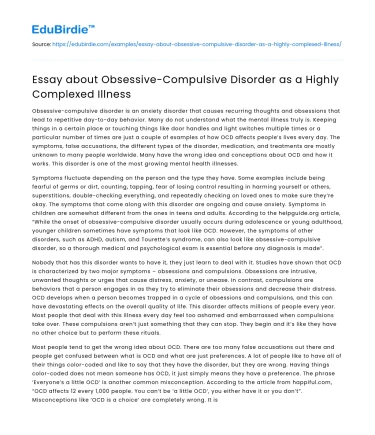Obsessive-compulsive disorder is an anxiety disorder that causes recurring thoughts and obsessions that lead to repetitive day-to-day behavior. Many do not understand what the mental illness truly is. Keeping things in a certain place or touching things like door handles and light switches multiple times or a particular number of times are just a couple of examples of how OCD affects people’s lives every day. The symptoms, false accusations, the different types of the disorder, medication, and treatments are mostly unknown to many people worldwide. Many have the wrong idea and conceptions about OCD and how it works. This disorder is one of the most growing mental health illnesses.
Symptoms fluctuate depending on the person and the type they have. Some examples include being fearful of germs or dirt, counting, tapping, fear of losing control resulting in harming yourself or others, superstitions, double-checking everything, and repeatedly checking on loved ones to make sure they’re okay. The symptoms that come along with this disorder are ongoing and cause anxiety. Symptoms in children are somewhat different from the ones in teens and adults. According to the helpguide.org article, “While the onset of obsessive-compulsive disorder usually occurs during adolescence or young adulthood, younger children sometimes have symptoms that look like OCD. However, the symptoms of other disorders, such as ADHD, autism, and Tourette’s syndrome, can also look like obsessive-compulsive disorder, so a thorough medical and psychological exam is essential before any diagnosis is made”.
Save your time!
We can take care of your essay
- Proper editing and formatting
- Free revision, title page, and bibliography
- Flexible prices and money-back guarantee
Nobody that has this disorder wants to have it, they just learn to deal with it. Studies have shown that OCD is characterized by two major symptoms – obsessions and compulsions. Obsessions are intrusive, unwanted thoughts or urges that cause distress, anxiety, or unease. In contrast, compulsions are behaviors that a person engages in as they try to eliminate their obsessions and decrease their distress. OCD develops when a person becomes trapped in a cycle of obsessions and compulsions, and this can have devastating effects on the overall quality of life. This disorder affects millions of people every year. Most people that deal with this illness every day feel too ashamed and embarrassed when compulsions take over. These compulsions aren’t just something that they can stop. They begin and it’s like they have no other choice but to perform these rituals.
Most people tend to get the wrong idea about OCD. There are too many false accusations out there and people get confused between what is OCD and what are just preferences. A lot of people like to have all of their things color-coded and like to say that they have the disorder, but they are wrong. Having things color-coded does not mean someone has OCD, it just simply means they have a preference. The phrase ‘Everyone’s a little OCD’ is another common misconception. According to the article from happiful.com, “OCD affects 12 every 1,000 people. You can’t be ‘a little OCD’, you either have it or you don’t”. Misconceptions like ‘OCD is a choice’ are completely wrong. It isn’t a choice, no one would want to live with a mental illness.
The different types are mostly unknown to nearly everyone. There are five major types that are the most common, but someone can have more than one type. The first type is contamination and washing, which is an obsessional worry of being contaminated and having germs everywhere. The obsession with germs causes fears that they will hurt themselves or a loved one. The second type is harm and checking. Checking is a compulsion and a fear that someone will be hurt or something will be damaged. Checking also results in doing rituals and other compulsions to prevent the act from happening. The third and most known type is symmetry, arranging, counting, and just right OCD. This type causes the person to make sure everything is lined up symmetrically and feels ‘right’. Picking something up and sitting there to make sure it’s put down exactly how it was or how the person wants it. Also, these are the compulsions where the ‘right number’ comes out. Turning lights on and off or closing car doors four times because ‘four is a good number’.
Many different types of medication and therapy are used to treat the illness, but there is no cure. The different types of antidepressants include clomipramine, fluoxetine (Prozac), fluvoxamine (Luvox), paroxetine (Paxil), sertraline (Zoloft), etc. Other treatments include psychotherapy, support groups, aversion therapy, and cognitive behavior therapy. These medications also tend to treat anxiety and depression that can be caused by obsessive-compulsive disorder.
In conclusion, OCD is a growing disorder and affects millions of lives every day. More people need to know the truth about OCD, not the misconceptions. There are so many people who do not know about it and might need to know later on when it comes to mental illness. This mental illness is very complex and usually misunderstood. More research and studies should be performed to look more in-depth because so many suffer from this crucial illness. Obsessive-compulsive disorder is a constant struggle and something that should be researched more. Everyone should remember that nobody who has this illness wants it. It is something that they have to live with and learn to deal with. There is no cure whatsoever. Yes, there is medicine and treatment for it, but that is not a cure, it is simply putting a band-aid over a large cut; it works for a little bit, but it never stops the bleeding. There needs to be something done about this. People with this illness need to be heard.






 Stuck on your essay?
Stuck on your essay?

